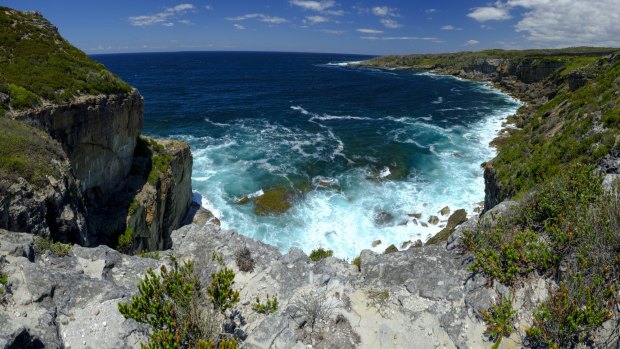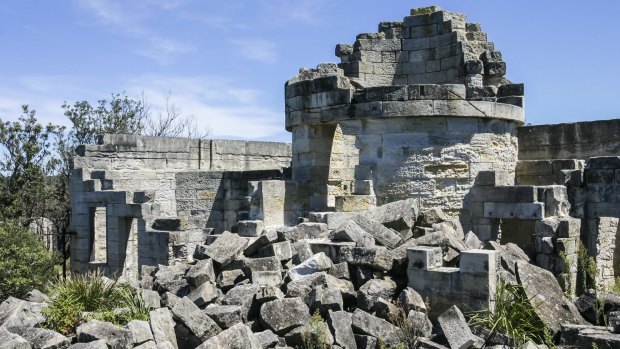This was published 2 years ago
Cape St George Lighthouse ruins, near Jervis Bay: Built in the wrong place, this lighthouse killed more than it saved
By David Whitley

The Cape St George Lighthouse is in a dramatic coastal location. It's also in the wrong location. Credit: iStock
The sandstone blocks of the Cape St George Lighthouse tumble over each other in a higgledy-piggledy shambles. As the early morning light hits, there's a familiar vibe – like wandering alone round the ruins of a small Angkorian temple. But the coastal location adds to the drama. Come in winter and migrating humpback whales are regularly seen from the clifftop.
These days, the Cape St George Lighthouse is a beautiful, evocative and peaceful site inside the Booderee National Park, Jervis Bay. But this is perhaps Australia's most cursed lighthouse, and its story is one of calamitous error and personal tragedy.
For a start, the Cape St George Lighthouse is in the wrong place. It was built in 1860, and designed by colonial architect Alexander Dawson, who is best known for his work on the Sydney Observatory.

Eventually the lighthouse was destroyed with explosives, but its ruins remain.Credit: iStock
The planning stage was a comedy of errors. The Pilots Board wasn't given a say on the suitability of the site for ships, Dawson's map of the proposed location was less than comprehensive, and it seems a lazy contractor took advantage of that. The lighthouse was built about four kilometres north of where it was supposed to be, probably because it was easier to get the stone there.
The end result was a lighthouse that was pretty much useless. It couldn't be seen from the northern approach, and could barely be seen from the southern approach either.
It took 39 years for this mistake to be rectified. A new lighthouse was built at Point Perpendicular on Jervis Bay's northern head in 1899. But that was too late for several ships. The Department of Agriculture, Water and the Environment lists 13 ships that were wrecked around Jervis Bay in that period. Other sources estimate that significantly more met their end.
But even when the new, usefully-placed lighthouse had kicked into gear, there was a problem. There were now two lighthouses very close to each other. One of them marked the entrance to the bay, and the other could easily be mistaken for it. When the moonlight hit the sandstone, the Cape St George Lighthouse was an outright hazard, potentially luring ships onto the rocks.
Eventually, the decision was made to take the tower down with explosives, creating the ruins we see today.
But the Cape St George Lighthouse wasn't just a curse for passing ships – the inhabitants had a rough time of it too. For a start, getting supplies to the lighthouse was a nightmare. The nearest place anyone could safely land a boat was Murrays Beach, 4km away. Horses were required to lug supplies from the beach, and there was not enough grass for the horses.
More disturbingly, a run of grave misfortune befell those who lived by the Cape St George Lighthouse. Interpretive signs mention a few of the unlucky ones, kicking off with Isabella Jane Lee. She was the daughter of the principal lightkeeper, and in 1867 succumbed to typhus fever.
It wouldn't be the last death here. Thirteen-year-old George Gibson died from pleurisy in 1882, while 11-year-old Florence Bailey was taken by typhoid in 1885.
However, the accidents are more macabre than the deaths from disease. Florence Bailey's father, Edward, was washed off the rocks while fishing and eaten by sharks as his son looked on.
Francis Henry Hammer, thought to be nine or 10 at the time, lost his footing and toppled off the cliff while pushing rocks around for entertainment.
Assistant lightkeeper William Markham, meanwhile, got kicked in the head by a horse and died before he could get to Nowra Hospital.
Perhaps most tragic of all was the death of Harriet Parker in 1887. The assistant lightkeeper's daughter was shot dead by her friend, the main lightkeepers daughter. It's believed that the latter tripped while playing around with a loaded gun.
Visit the ruins these days, and the Cape St George Lighthouse seems serene. But the grim past suggests that this lighthouse cost more lives than it saved.
DETAILS
MORE
parksaustralia.gov.au/booderee
VISIT
The Cape St George Lighthouse is at the eastern end of the Booderee National Park in the Jervis Bay Territory. A two day pass for the national park costs $13 per vehicle.
STAY
Unpowered camping sites within the national park cost from $25 a night. Otherwise, stay in nearby Huskisson. The Huskisson Beach Resort offers colourful bungalows for from $100 per night. See huskissonbeachresort.com.au
David Whitley travelled courtesy of Tourism Australia.
Sign up for the Traveller Deals newsletter
Get exclusive travel deals delivered straight to your inbox. Sign up now.